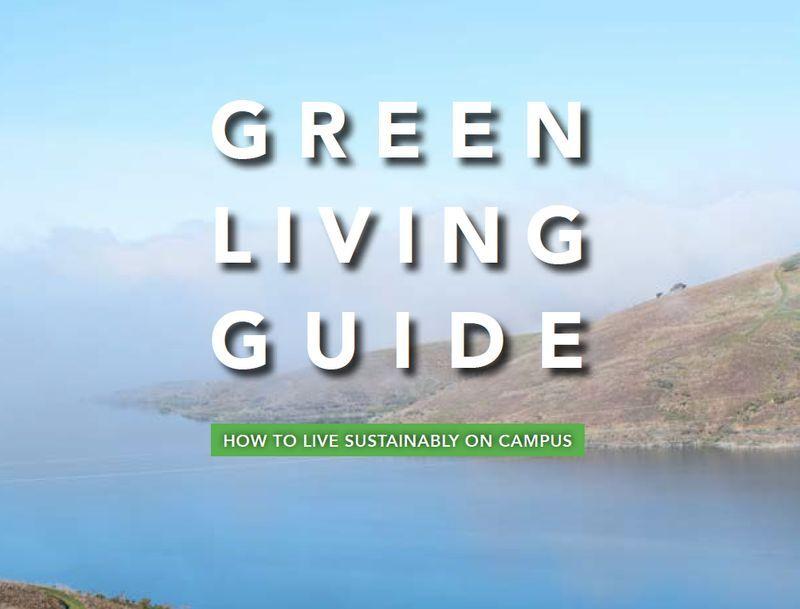Developed by Cal Poly Honors in cooperation with Facilities Management & Development Energy, Utilities, and Sustainability
Cal Poly is committed to achieving carbon neutrality and climate resilience by 2050. For Earth Day 2016, President Armstrong signed the Second Nature Climate Leadership Commitment, making Cal Poly a Charter Signatory to the largest climate change initiative in higher education.
Cal Poly’s definition of sustainability — the ability of the natural and social systems to survive and thrive together to meet current and future needs
Over 30% of campus is LEED certified. In 2018, Cal Poly has earned a total of 32 California HigherEd Sustainability Best Practices awards (more than any other CSU campus). AASHE STARS Silver Rated University. In signing the Talloires Declaration in 2004, President Baker emphasized Cal Poly’s commitment to sustainability.
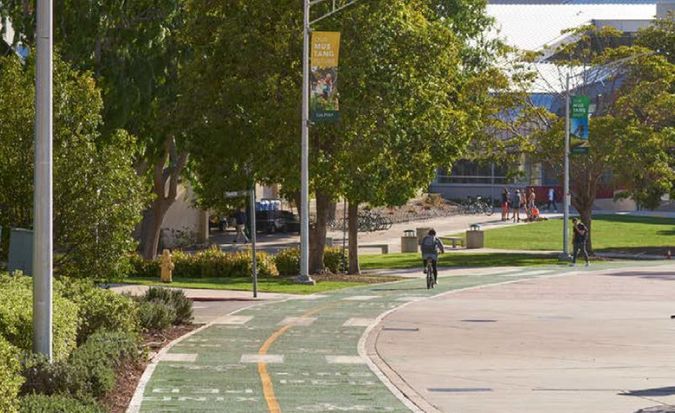
GREEN LIVING CHECKLIST
What ways are you already living green? What can you add to your routine to improve?
Water
☐Wash full loads of clothes using cold water
☐Take shorter showers (around 5 minutes)
☐If possible, reduce the times per day you shower
☐Report leaky faucets to your RA
☐Don’t let the sink run while you brush or shave
Energy
☐Unplug electronics & appliances when theyare not in use
☐Open blinds for natural light during the daytime
☐Turn off lights when you do not need them
☐Reduce your rooms heating and cooling use
☐Take the stairs instead of the elevator
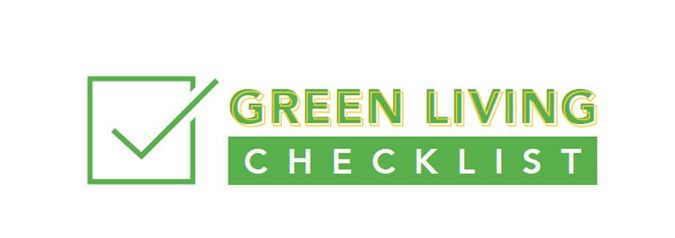
Eating
☐Go vegetarian or vegan
☐Eat local through farmers markets and on-campus selections
☐Get involved in a community garden
☐Bring snacks in reusable containers
☐Always carry personal utensils and a reusable water bottle
Waste
☐Recycle in your room
☐Ask your RA about composting food scraps
☐Always keep reusable bags with you to avoid using plastic
☐Donate unwanted goods instead of throwing them away
☐Use reusable dish ware in your room
Transportation
☐Walk or bike whenever possible
☐Carpool with friends
☐Take advantage of SLO’s FREE bus system
☐Consider buying an electric or fuel efficient car
Community
☐Volunteer on and off campus
☐Join clubs and organizations on campus that support sustainability
☐Talk to your neighbors and friends about sustainability
☐Attend sustainability and social justice events on campus and in the community
☐Make sure to register to vote and vote in campus, local, state and federal elections
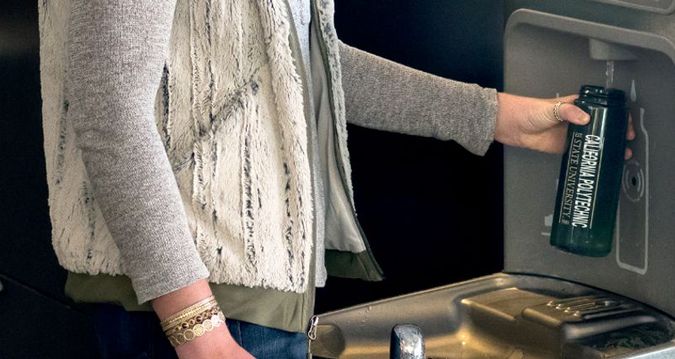
WATER-WISE
Since 2015, Cal Poly water usage has been reduced by 31%. 141,419,521 gallons of water have been saved due to water conservation efforts, resulting in $500,000 savings of water and sewer utility costs.
Things you can do to save water
- Wash full loads of clothes. Doing laundry takes about 40 gallons of water each load, so washing full loads of laundry can save a lot of water over time.
- Take shorter showers. Make a 5 minute playlist and keep showers within that playlist’s time. Showers use about 2 gallons of water per minute, so cutting down on shower times saves more water than you may think!
- Fix leaky faucets. Leaky faucets can cost up to 2,000 gallons of water per year. Call your RA, CSD, or Facilities to get help. Facilities Help Line: 756–5555.
- Save energy — saving energy saves water as well. The production and use of water is related to the production and use of energy. 20% of all electrical energy consumed is used for the pumping, treatment and transport of water.
- Measure your water usage on this water calculator to understand your impact. Remember that direct water usage is not the only aspect of your water usage. Outside effects such as diet also affect your water usage.
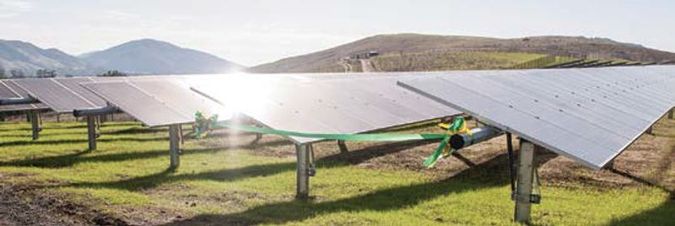
SAVING ENERGY — WHAT CAL POLY IS DOING
- In 2017, Cal Poly dedicated a new solar farm that will provide 25% of all electricity on campus.
- Cal Poly is currently looking into the implementation of biomass energy that would reduce greenhouse gas emissions and simultaneously generate energy.
- Facilities completed a $3.3M energy and water conservation project in 2016 which resulted in savings of over 2,000,000 kWh of electricity, 47,000 therms of natural gas.
- Over summer 2016, nearly 500 street and parking lot lights on campus were retrofitted to LED, with motion sensing dimming technology in parking lots. The project resulted in savings of over 300,000 kWh per year in electricity, and qualified for a utility incentive of $70,000
What you can do to help
- Turn off your lights at night and when you leave the room.
- Unplug electronics and appliances when you aren’t using them.Unplugging reduces energy consumption because electronics can continue to drain electricity even when they are turned off.
- Turn off the heat at night (use blankets as a replacement). Also feel free to open your windows to cool down a room, rather than using the air conditioning.
- Use sunlight when possible rather than electricity.
- Enable power saving mode on your computer. Consider calculating your total energy usage with this handy tool.
EATING GREEN — WHAT CAL POLY IS DOING
- In 2017, Campus Dining was honored with a Best Practice Award in Sustainable Food Systems from the California Higher Ed Sustainability Conference for our efforts to increase food sustainability through procurement, production, waste practices, and community partnerships.
- More than 100 local and organic products are sold on campus.
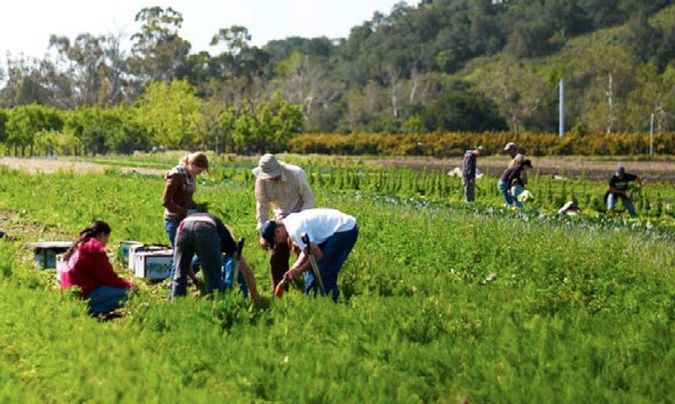
What you can do to help
- Eat local and organic. You can hit up SLO’s famous downtown farmers market on Thursday nights and keep an eye out for other local markets too. It’s a fun excuse to get off campus and also be green!
- Try meal planning for the week and plan your grocery list with your meal plan to prevent buying too much of an item that may spoil. Try resizing your meals too. You may discover that you don’t need as much food as you thought!
Sustainably-conscious eating habits are not only good for the environment & society, but also your health & your wallet!
- Pack your snacks in mason jars or reusable containers to reduce packaging waste. Bring your own cup to Starbucks to not only be sustainable, but get a 10 cent discount!
- Take it easy on meat. Meat requires more food, water, land, and energy than plants to produce.
- Read labels so you know where your food comes from. Use the Cal Poly app’s Dining tab to see food options, prices, and open hours at campus dining venues! To help create a sustainable food environment, Cal Poly offers rbgh-free yogurt and milk, Fair Trade certified coffee, cage free eggs, and imperfectly delicious organic produce.
Fast Facts
- When you shop at farmers’ markets, a higher margin, 80 to 90 cents, of each dollar spent by the consumer are kept by farmers.*
- It takes 2,500 gallons of water, 12 pounds of grain, 35 pounds of topsoil and the energy equivalent of one gallon of gasoline to produce one 16 oz. beef steak.
- The Life Cycle study found that red meat accounts for about 150 percent more greenhouse gas emissions than chicken or fish.
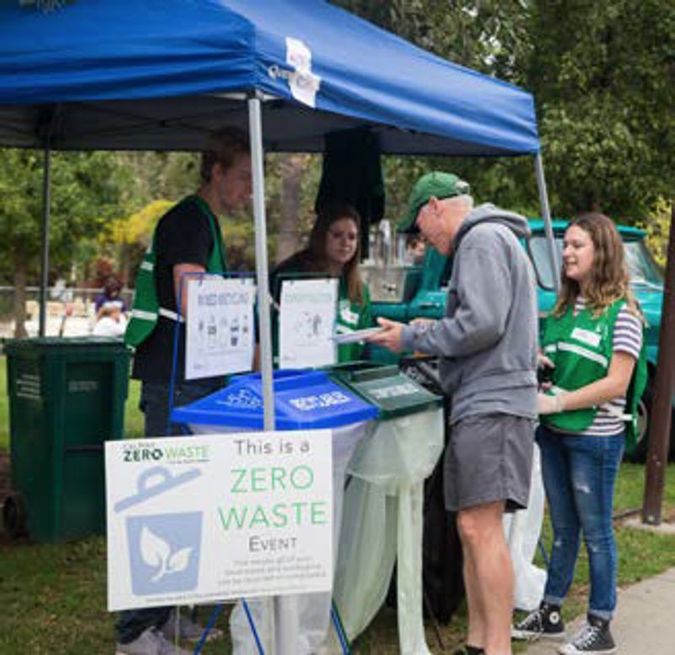
GOING ZERO WASTE — WHAT CAL POLY IS DOING
- Cal Poly reduced its landfill disposal by 58% over the last ten years, with a waste diversion of 90% from the landfill in 2016 (the highest rate ever)!
- We plan to achieve an average waste diversion rate of 80% by 2020.
Agriculture Operations converting over 7 million pounds of animal manure and landscaping waste into high quality compost to use on campus and to sell. - Campus Dining annually recycles an impressive 193,000 pounds of cardboard and composts 230 tons of food scraps and coffee grounds.
- In 2015, operations staff from FM&D, University Housing, ASI, Campus Dining, the Green Campus Program, and Zero Waste Club came together and formed a Zero Waste Collaborative to help Cal Poly achieve its sustainability goals.
The five R’s of Cal Poly zero waste — Refuse, reduce, reuse, repurpose, recycle
What you can do to help
- Understand how to properly use the food waste bins across campus.
Refer to the visual guides posted above waste bins across campus! - Whether living on or off campus, have a recycling bin and try composting.
- Purchase products with recyclable packaging or no packaging at all.
Buying in bulk, anyone? - Always value quality over quantity! “Fast fashion” may be fun, but short product lifespan of clothing has a big impact! Each year over 80 billion pieces of clothing are produced worldwide. 3 out of 4 garments will end up in landfills or be incinerated, with only a quarter being recycled. Make an impact and invest in quality, reusable clothing. Search for products made from recycled materials! The University Store has lots of options for common class materials which are and can be recycled.
- Consider thrifting and donating your old goods. Make some green while being green!
- Use reusable containers, utensils, and shopping bags.
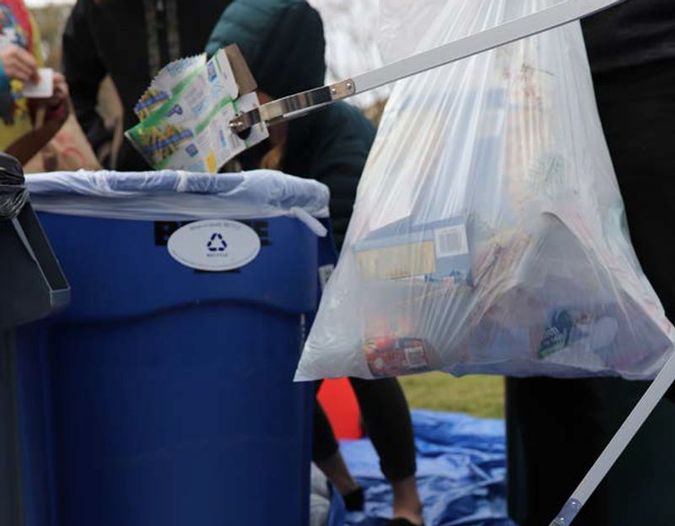
To recycle or not to recycle
Although you may hear some people who say “when in doubt, recycle,” you need to know what can be recycled to avoid contaminating Cal Poly’s waste stream.
- Paper/Cardboard — Paper makes up nearly 30% of trash generated in the US each year, more than any other material!To further combat paper waste, consider taking notes on a computer and printing double-sided when possible.
- Plastics — With an estimated 8 million metric tons of plastic entering oceans every year, plastic products have a reputation for harming marine life. Plastics labeled 1 through 7 (except 6, products like Styrofoam and ubiquitous red cups) can be recycled at Cal Poly.
Carry your own utensils and drink containers to make refusing plastic easier!
- Glass/Aluminum — Glass bottles can often be reused as well!Aluminium foil and cans are common recyclable materials.
What about compost
Any food scraps can be thrown away in the Zero Waste compost bins on campus.Move-Out is a great time to be zero waste! Donate items you don’t need (i.e. clothes, food, electronics, small furniture items, etc.) at your building’s drop-off location, which will be indicated by posters and via email, and don’t forget to recycle!
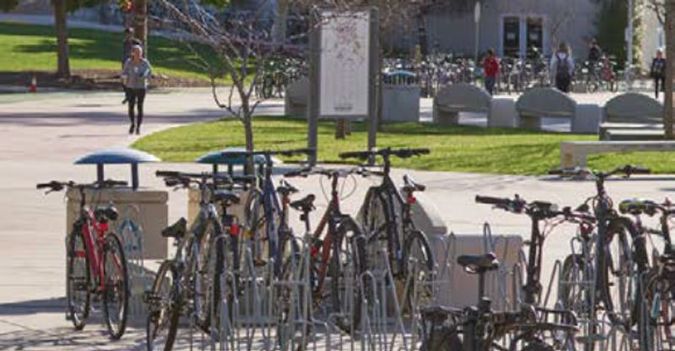
TRANSPORTATION — WHAT CAL POLY IS DOING
- In early 2015, San Luis Obispo was labeled a Gold Level Bike Friendly Community by the League of American Bicyclists, making it one of a select few communities nationwide revered for safe and encouraging bicycling.
- On Cal Poly’s campus there will be 8,163 bike racks by the 2018–2019 school year, which allows for easy on and off campus commuting by bike by students and faculty.
- There are currently 10 commuter vans that take 147 single-occupant vehicles off the road daily, from Paso Robles to Orcutt. The program is paid for by a rider membership fee, and saves members an average of$1,700 per year and reduces their Greenhouse Gas emissions by almost 90 percent!
- Subsidized by campus parking fines, the SLO city buses remain free for faculty, staff, and students.
- Cal Poly has one of the largest vehicle fleets of any CSU campus. To minimize the cost and environmental impact of this fleet, Cal Poly uses alternative fuel vehicles, including rechargeable electric, propane, bi-fuel (gas/propane), gas hybrid, and biodiesel.
What you can do to help
- Walk or bike around campus.Use the Cal Poly App’s Biker Tracker to see how many available bike rack spots there are across campus, as well as repair stations to keep you going!
- Bike, bus, or carpool off campus every time going somewhere local. Download the SLO Transit App to use the bus system and keep an eye on routes 4A and 4B to back to campus!
- Join the Cal Poly ride share Facebook page. This makes finding a carpool to travel farther away from campus easier while helping you meet new people!
- Take advantage of shared transportation like ZipCar. For students living on campus, ZipCar eliminates the need to bring a car to campus. Zip Cars, including hybrid vehicles, are available for students on campus.
- Buy a used bike and look for used or energy-efficient options when buying a car. Over half, 51% of the greenhouse gas (GHG) emissions associated with Cal Poly campus result from daily commuting. Of these emissions, over 60% come from cars, either driven alone or as a carpool. Electric or fuel-efficient options will help you have a positive impact on the environment as you travel!

GET INVOLVED
There are opportunities both on and off campus to learn more about sustainability in all of its aspects (environmental, social, and economic) and make even more of a positive impact as a Mustang!
Interested in involving sustainability in your coursework?
Cal Poly has Sustainability Learning Objectives (SLOs) as part Cal Poly’s commitment to involving sustainability and environmental literacy in teaching, theory, and practice. suscat.calpoly.edu
In order to consider sustainability when making reasoned decisions, all graduating students should be able to:
- Define and apply sustainability principles within their academic programs.
- Explain how natural, economic, and social systems interact to foster or prevent sustainability.
- Analyze and explain local, national, and global sustainability using a multidisciplinary approach.
- Consider sustainability principles while developing personal and professional values.
Cal Poly’s Sustainability Catalog also lists all of available courses and programs which focus on sustainability. Find out more here
Looking to join campus organizations supporting sustainability efforts? There are nearly 30 student clubs focused on promoting sustainability. Consider joining Green Campus Program, Surfrider, Zero Waste Club, Empower Poly Coalition and many more! Check them out at Club Showcase or visit this site.
Be sure to participate in sustainability opportunities around campus! Take part in cool events like ACDC (a competition between residence halls put on by Green Campus) and Earth Week festivities to support sustainability and have fun!
You can visit sustainability.calpoly.edu to sign up for monthly updates and volunteer efforts, as well as learn more about sustainability efforts at Cal Poly at www.sustainability.calpoly.edu.

